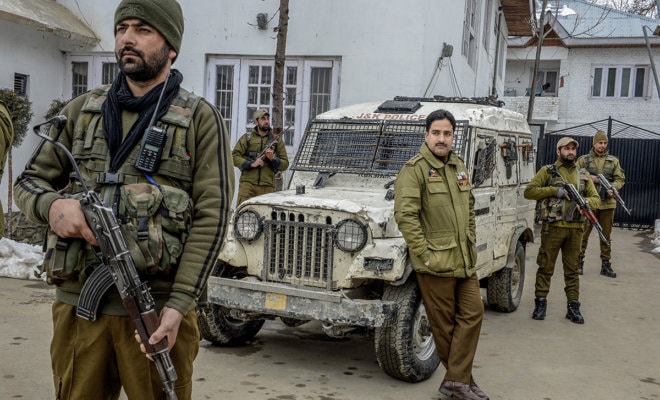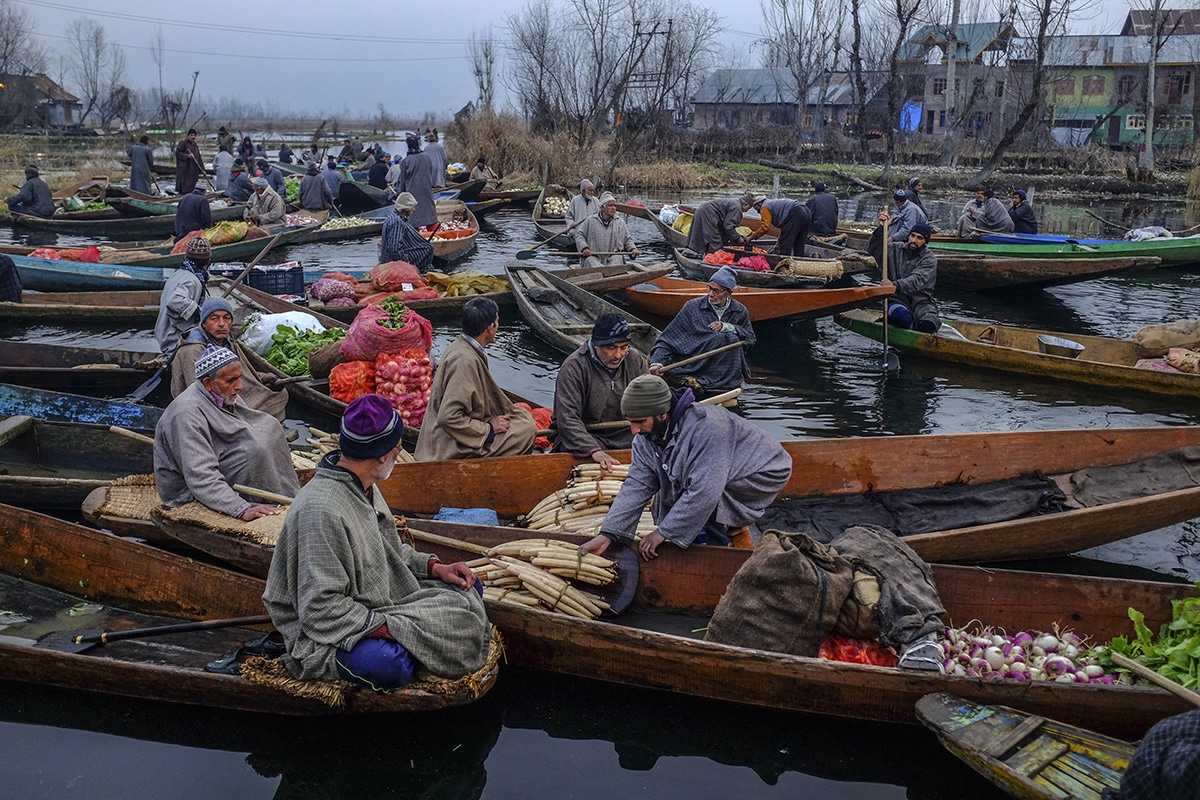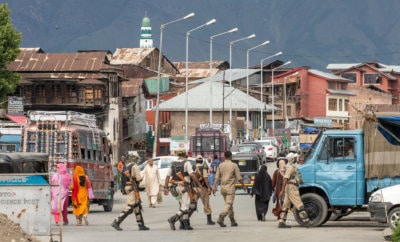India
Kashmir’s War Gets Smaller, Dirtier and More Intimate

Officer Ashiq Tak, center, with his bodyguards outside his office in Shopian, India, in the state of Kashmir, Feb. 16, 2018.
Photo: Atul Loke/The New York Times
Kashmir’s war, a territorial dispute between India and neighboring Pakistan, has smoldered for decades. Now it is collapsing into itself. The violence is becoming smaller, more intimate and harder to escape.
Years ago, Pakistan pushed thousands of militants across the border as a proxy army to wreak havoc in the Indian-controlled parts of Kashmir. Now, the resistance inside the Indian areas is overwhelmingly homegrown.
The conflict today is probably driven less by geopolitics than by internal Indian politics, which have increasingly taken an anti-Muslim direction. Most of the fighters are young men from quiet villages, who draw support from a population deeply resentful of India’s governing party and years of occupation.
Kashmir sits on the frontier of India and Pakistan, and both countries have spilled rivers of blood over it. Three times, they have gone to war, and tens of thousands of people have been killed in the conflict. It is one of Asia’s most dangerous flash points, where 1 million troops have squared off along the disputed border. Both sides now wield nuclear arms. And the two sides are divided by religion, with Kashmir stuck in the middle.

Vendors at a floating market in Srinigar, India, in the state of Kashmir, Feb. 15, 2018. Photo: Atul Loke/The New York Times
India, which has controlled most of the Kashmir Valley for the past 70 years, is predominantly Hindu. The valley itself is predominantly Muslim, as is Pakistan. But as the days pass, the conflict has become less of a religiously driven proxy war.
The rebellion, says Imran Khan, Pakistan’s presumed new leader, is now “indigenous.” Khan, who clearly has a Pakistani perspective on the conflict, says he is determined to negotiate an end to it. His persuasive election victory last month — and the fact that India’s prime minister, Narendra Modi, made a friendly phone call to congratulate him — suggests a breakthrough is possible.
But India still loves to blame Pakistan for all its Kashmir problems, which, according to Western intelligence agents, continues to send some money and weapons to militants in Kashmir. Many Indian politicians seem in denial that their own politics and policies might be a factor.
India’s swerve to the right in recent years, with the rise of the Hindu nationalist Bharatiya Janata party, has deeply alienated its Muslim minority. Many top members of the ruling party have a very questionable record when it comes to treating Muslims fairly. This has emboldened Hindu supremacists across India, and in recent years, Hindu lynch mobs have targeted and killed Muslims, often based on false rumors. Many of the culprits are lightly punished, if at all, leaving India’s Muslims feeling exposed.
In the Indian-administered parts of Kashmir, where there was already a history of bitter conflict, the new politics have spurred more people to turn against the government. Some pick up guns, others rocks, but the root emotion is the same: Many Kashmiris now hate India.
“This is what’s different,” said Siddiq Wahid, a Kashmiri historian who earned his doctorate from Harvard. “Before, in the 1990s, many Kashmiris felt we can negotiate this, we can talk.”
“But nobody wants to be part of India now,” he said. “Every Kashmiri is resisting today, in different ways.”
The latest are children and grandmothers. At almost every recent security operation, as Indian officers closed in on houses where militants were believed to be hiding, they have had to reckon with seething crowds of residents of all ages acting as human shields.

Photo: Atul Loke/The New York Times)
Walk through Kashmiri villages and ask people what they want. The most common response is independence. Some say they want to join Pakistan. None say anything good about India, at least not in public.
India’s steely response has pushed away even moderates. Soldiers manhandle residents, cut off roads and barge into homes, saying they are looking for militants, who often hide among ordinary residents. When violent protests erupt, the Indian security services blast live ammunition and buckshot into the crowds, killing or blinding many people, including schoolchildren who are simply bystanders.
But while protests against Indian rule have grown in number and size, the armed militancy has become surprisingly small, partly because Pakistan is not providing as much support as it used to. Security officials say there are only around 250 armed militants operating in the Kashmir Valley, down from thousands two decades ago. Most of them are poorly trained. But still, the Indians cannot stomp them out.
“I’ll be honest,” said Mohammad Aslam, a police commander in southern Kashmir. “For every militant we kill, more are joining.”
More than 250,000 Indian army soldiers, border guards, police officers and police reservists are stationed in the valley, outnumbering the militants 1,000 to one. Most militants do not last two years. One fighter, a former college sociology professor, was killed in May just two days after he joined.
Their attacks tend to be quixotic and they usually die in a hail of automatic weapon fire. Their assassinations and killings are not militarily significant, more acts of protest against Indian rule. Of the approximately 250 known militants, police officials said, only 50 or so came from Pakistan, and most of the rest, the locals, have never left the valley.
Kashmiris speak of a psychological tension that divides communities, individual families and sometimes even the same person. On one hand, people want to support a functioning society — to have their children go to school, get jobs, see some economic development — and Indian control represents that. On the other, they feel real sympathy for a cause, Kashmiri independence, that they consider just.
“Let’s be realistic: India’s never going to give up this land,” said one young Kashmiri who asked that his identity not be revealed because he could be labeled a collaborator.
“I can say such things in my house. But as soon as I step outside, even into my own street, I can’t say that. It has to be ‘Azadi! Azadi! Azadi! ‘ he said, using the word for freedom.
He sighed. “It’s exhausting.”
© New York Times 2018



